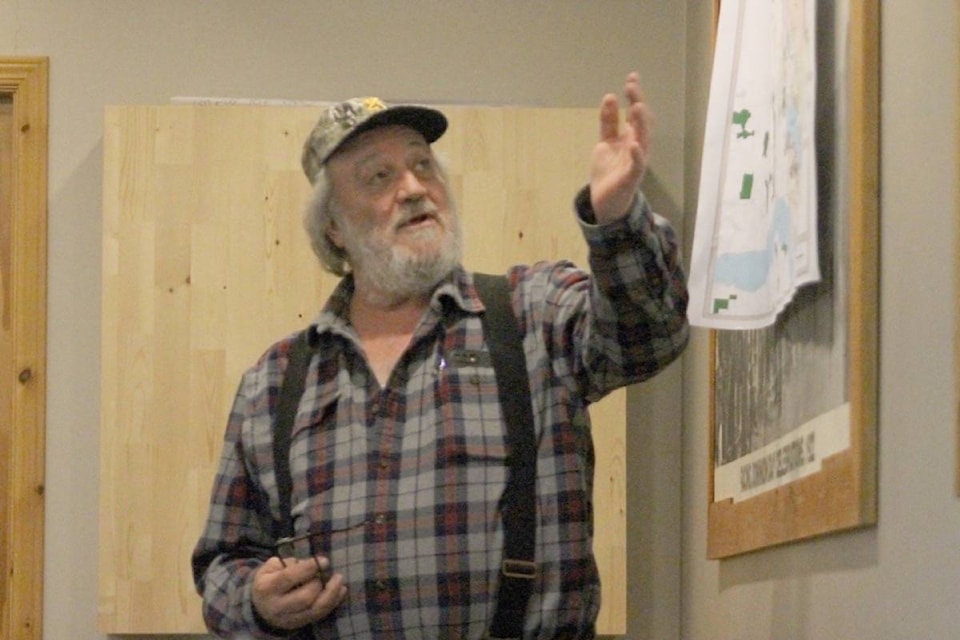Local resident Miles Fuller, who’s had a lengthy career and involvement in the forest industry, is warning Burns Lake council that more needs to be done to prevent a catastrophic wildfire.
“We’ve got steep slopes, dead pine trees, and blowdown. You couldn’t make that more volatile except maybe for dumping gasoline on it,” he warned council during a recent council meeting.
READ MORE: Threat of fire ‘imminent’ at Boer Mountain site
Fuller is a 40 plus year resident of the Burns Lake area. His involvement in the forest industry includes being the current president of Chinook Community Forest, co-chair of the Land and Resource Management Plan for the Lakes District, and past president for the Federation of B.C. Woodlot Associations. Fuller explained that the mean fire interval for forests around Burns Lake is about 140 years.
“If you go back for thousands of years, forest fires have burned through here every 140 years,” he explained. “It’s part of the ecology of the Interior - we’re not the coast where forests live to be thousands of years old; they just don’t live that long here.”
Fuller says some forest landscape ecologists now believe that, over the next 10 years, the mean fire interval is expected to drop across the western parts of Canada and the U.S. by approximately 40 to 50 years.
“We could be looking here in a few years at a fire return interval of 80 to 90 years, not 140,” said Fuller. “With the fuel loading we have on the landscape, we basically are setting ourselves up here for a large wildfire.”
Fuller also warned that home insurance costs are expected to go up in B.C. due to increased fire risk.
“There’s a lot people living in rural areas who are not putting fire insurance on their houses because they can’t pay for it,” he said. “I’m afraid we’re going to be in a position where a lot of people, even in the fire protection district, are not going to afford insurance because their prices are simply going to go up.”
In addition, Fuller said there could be some liability issues for elected officials in the event of a catastrophic wildfire in the Burns Lake area.
The mountain pine beetle infestation has resulted in historic high levels of dead material that is in the process of blowing down and creating stands with a high to extreme fire hazard in the Burns Lake area. Fuller said one of the solutions would be having a two-kilometre plowed field around town. However, he wasn’t sure about the feasibility of this project.
“To me that’s extreme, but that is almost what you need to protect the community,” he said. “We need to reduce the fuel in any way we possibly can.”
“My opinion is that we need a variety of things,” he continued. “One of the things they are finding out of the fires [in the B.C. Interior this past summer] is that green aspen has helped slow down these catastrophic fires.”
After Fuller’s presentation, Burns Lake Mayor Chris Beach asked what could the town do to improve its appearance if council went ahead with the idea of implementing a two-kilometre plowed field around town.
Fuller said that after the 2017 wildfire season, municipalities are more concerned about fires than about how they look.
“No one is putting a lot of thought into what comes after [implementing fireguards],” said Fuller.
Frank Varga, general manager of the Burns Lake Community Forest (BLCF), says that reducing the local fire hazard is one of the community forest’s main challenges.
“If you look upon the southern hillsides of Burns Lake, you may have noted considerable blowdown,” he said. “These areas no longer look how they were intended to and are now a major fire hazard to our community and the long-term viability of the community forest. Our challenges ahead are not only to find a sustainable and economically viable harvest level, but long-term strategic hazard assessments while maintaining the social and environmental values at heart,” he continued.
The Land and Resource Management Plans (LRMP) of the late 1990s, and LRMP amendments of the last couple of years, did not contemplate the extent of landscape-level changes that came with the mountain pine beetle epidemic of 2004 and beyond,” he added.
Earlier this year, Varga announced that the BLCF plans to mitigate wildfire risk at the Boer Mountain Recreation Site by removing dead pine. Eventually, the BLCF plans to map the entire K1A licence (approximately 92,000 hectares) to conduct this same work.
Between 2007 and 2016, there was a total of 111 wildland fire starts within the radius service area of the Village of Burns Lake – an average of 11 per year.
The CWPP update identified new areas for fuel treatment work around Burns Lake, including the Omineca Ski Club’s entrance, Boer Mountain and Kager Lake recreation sites, as well as the area east of Burns Lake known as Industrial Park.
@flavio_nienow
newsroom@ldnews.net
Like us on Facebook and follow us on Twitter.
